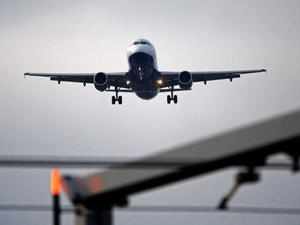 Agencies
AgenciesIqbal’s sights, though, are set skywards. The Delhi resident completed his commercial pilot licence (CPL) two years ago, but was unable to find a job as a pilot due to the economic downturn in 2019, and the Covid-19 pandemic the next year.
Hundreds of pilots in the country are staring at a long wait to get the job of their dreams, and many like Iqbal are pursuing other alternatives to maintain an income or supplement their skills. According to industry estimates, around 600-800 CPLs are issued in India every year, some to pilots who have been trained abroad. But hiring has been virtually non-existent since the pandemic grounded Indian airlines last year. Industry estimates put the total number of pilots employed in India at around 10,000.

According to air-force veteran and aviation expert Dinesh Nair, this was a period when not only did pilots have opportunities with Indian airlines, Middle-eastern airlines too became an attractive destination for Indian pilots.
In April 2019, though, Jet Airways, which had a fleet of more than 100 aircraft, grounded its operations. Despite this, scheduled operators added about 20 aircraft to their fleets until March 2020, which meant an addition of about 160-240 jobs. However, the DGCA had issued about 821 new licences in this period.
And then Covid-19 hit. In FY20, India's passenger traffic was 341 million. In FY21, though, it had crashed by 66%, according to statistics from the Airports Authority of India. Indian airlines have since them introduced a variety of measures to stave off losses, including job cuts, paycuts and leaves without pay. Pilots already employed, though, haven’t lost their jobs so far. But hiring is slow, to say the least, and even those who have gotten offer letters two years ago haven’t been able to fly yet. Vistara said it has reinstated salaries of all junior and mid-level staff this April, including reversing a 10% paycut taken by pilots, said Deepa Chadha, senior vice president, HR and Corporate Affairs, Vistara. Chadha said that the company had frozen hiring when the coronavirus-related pandemics hit last year, and has since started hiring “carefully” for business-critical roles and key replacements.
Market leader IndiGo which in July 2020 had announced that it would be laying off 10% of its staff (which did not include pilots), has since started hiring pilots in its cadet training programme. The company had also announced paycuts of 38% and 28%, respectively, for senior management and others, respectively, and those continue to be in force.
A Spicejet spokesperson said that in April this year, the company implemented a "graded deferment" of salaries for some of its higher-paid employees, which will be paid in full once the situation improves.
YN Sharma, CEO of Chimes Aviation Academy which is one of the leading flying schools in the country, says that this is only a phase. “India is yet to reach its potential in terms of air travel.” Around 60-70 pilots graduate from the academy every year. Sharma says that the number of applicants to join the academy has dropped by about 50% since the pandemic last year, although the intake remains the same.
Sharma says that there’s an “immediate gratification” element to becoming a pilot. Once you land a job, salaries start from a minimum of around 1.25 lakhs a month for a first officer, going all the way upto Rs.5-6 lakhs a month on becoming a captain. And accompanying it is a glamor matched by few other jobs.
But how long does this take to get employed? A 31-year-old pilot from Bengaluru, who did not wish to be named, said that he got hired by a major airline in May 2018, within five months of finishing his CPL.
But for yet others, like 30-year-old Snehal Dhawan, it was a much longer wait. Dhawan landed her first job as a pilot in 2018, seven years after she finished her CPL from an Australian flying school.
Dhawan is now flying. But many, like a 28-year-old pilot from Navi Mumbai ,who got an offer letter from an Indian airline in 2018, have not even been inducted. Availability of aircraft for training is a big issue, along with a shortage of spare parts, said a 30-year-old Noida-based pilot who completed his CPL from the US under one of the cadet training programs for a leading Indian airline. “The rental market for aircraft in India also doesn’t exist, unlike the US,” he said.
Dhawan said that of the six Indians in her batch, only three stuck to a flying career. For the others, the wait just got too expensive.
The cost of training to get a CPL varies between Rs.30-50 lakhs, depending on how long it takes to clear all the exams, practical and written. On top of that, pilots have to spend a minimum of Rs.15-20 lakhs to get a “type-rating”, which certifies their ability to fly a certain aircraft, like an Airbus 320, or a Boeing 787.
But more often than not, the expenses don’t stop there. Since pilots are in charge of large, complicated vessels ferrying hundreds of passengers through the skies, they have to keep their skills current. This means that if an unemployed pilot hasn’t been airborne in the last six months, and is applying for a job, they have to undergo training. This happens both on ground, on simulators and in the air to ensure their skills are fresh, at their own cost.
The simulators, which are priced anywhere between $6-8 mn a pop, cost about Rs.30,000-35,000 an hour to operate.
Several airlines like IndiGo and AirAsia now offer cadet training programs, where they select students from flying schools in the beginning of their training and offer them a package that can cost upto Rs.1 crore. Those who are selected have their training and type-rating taken care of, and are also assured a job at the end. Industry experts say that this is becoming a popular option for the deep-pocketed.
Download The Economic Times News App to get Daily Market Updates & Live Business News.
Read More News on
Download The Economic Times News App to get Daily Market Updates & Live Business News.









 Get Unlimited Access to The Economic Times
Get Unlimited Access to The Economic Times
